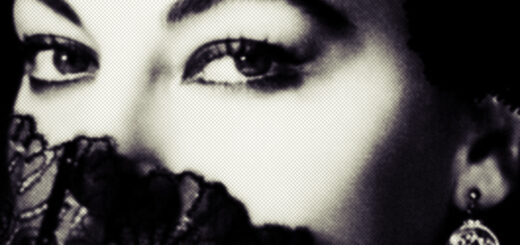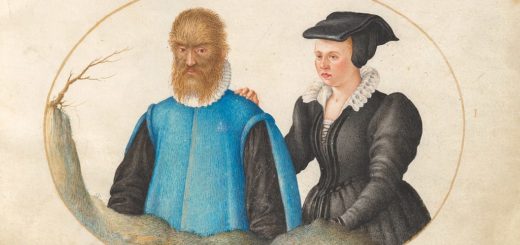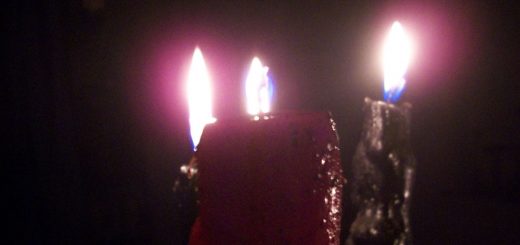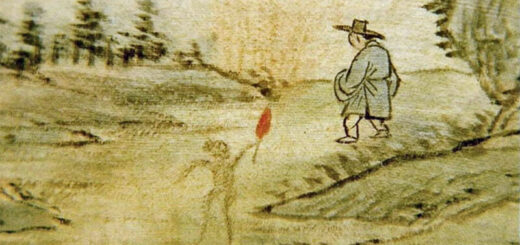Sexual magick – the history, the secrets and the big picture
Sexual magick, in most cases, refers to the linking of sexual and magickal practices in the context of modern Western occultism and, more broadly, modern spiritual movements in the Western world and the concepts associated with them. The most interesting and effective forms of sexual magic can probably be found in India and the practices of Taoist schools like the Taiwanese school of the White Tigres but while using much more effective techniques than western occultists they are usually categorized under the headings Tantra and Tao.

Manuel Orazi – Black Mass from L’assiette au beurre, Dec 12, 1903
Paschal Beverly Randolph is regarded as the most influential representative of “western” sexual magick practices, but the roots go back much further. See for example the worship op Fascinus, Priapus, Venus-Porna, the ancient Greek erotic extatic unity with Aphrodite or Eros and the Sabbath and use of ointments within the Indo-European witchcults. Other important protagonists of sexual magick include Randolph Theodor Reuss, Aleister Crowley, Julius Evola, Gerald Gardner, Guido Wolter (Frater Daniel), Gregor A Gregorius, Anton Szandor LaVey, Austin Osman Spare, Dion Fortune, Rosaleen Norton, Kenneth Grant, Peter J. Carroll, Annie Sprinkle, Frank Lerch and Jason Miller.
Introduction sexual magick
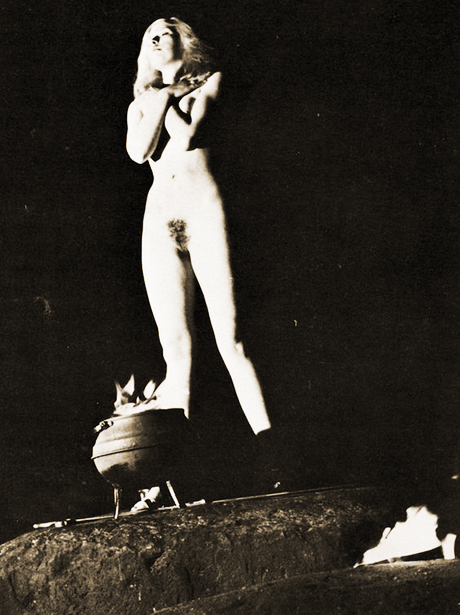
Maxine Sanders Queen of the witches in the seventies, performing a ritual.
Among the various representatives of sexual magick, two main directions can be distinguished: the one aimed at a spiritual exaggeration of sexuality, in which sexual encounter is perceived as magical in nature, and the other, in which sexuality is a magical means to an end, a source of energy that can be tapped through sexual actions and rites and is used by the magician as an instrument for achieving his goals. For example, Randolph represents the first position, Crowley the second.
While Randolph associated his theories exclusively with marital love and sexuality, the Ordo Templi Orientis (OTO) and Aleister Crowley developed forms of sexual magick in which non-reproductive forms of sexuality that broke norms and taboos, such as homoeroticism, autoeroticism and sadomasochism, played an essential role. The more a sexual practice deviated from the social norm, the more the sexual magickal energy released by its practice was considered.
The emergence of sexual magic towards the end of the 19th century is seen by some cultural scientists as an anticipation of the emergence of a freer sexuality, of a libertine approach to it, and of the intensive preoccupation with sexuality in modernity.
The opposite position, which rejected sexuality in occultism in principle and partly regarded celibacy as an essential element of occult practice, also developed in the 19th and 20th centuries. Especially in the USA this tendency to celibacy was very widespread. For example, in Hiram Butler’s Esoteric Fraternity the doctrine of abstinence was spread, which as such already led to the development of the mind. Also the Hermetic Order of the Golden Dawn, Theosophy and other occult organizations rejected sexual magic in principle.
Love magic and similar practices, such as potions, amulets and rituals against impotence or to increase potency, which have been handed down in numerous examples since antiquity, are not counted in the area of sexual magick. For in love magic magical practices are used to promote sexuality, whereas in sexual magic, as part of modern esotericism, sexuality is used to work magic and promote spiritual development.
The comprehensive scientific treatment of the topic of sexual magick with modern methods is in its infancy. Hugh B. Urban notes that apart from isolated works on specific topics (he names John Patrick Deveney, Joscelyn Godwin and Alex Owen in particular), there have been no reviews and the volume of scientific literature is disproportionate to the volume and impact of esoteric and popular literature with its flood of titles such as Celtic Sex Magic, Wicca for Lovers and, of course, the Complete Idiot’s Guide to Tantric Sex.
History of sex magick
Sexual magick is difficult to distinguish from sexual rites found all over the world and in all epochs, which in religious studies, ethnology and related sciences are understood as ritual acts connected with sexuality, such as phallic cults (see the ritual worship of Lingam and Yoni in South Asia), hierogamy or temple prostitution. This problem of demarcation corresponds to the general problem of distinguishing between cultic and magical actions.
In addition there is the problem that with the vegetation cults, initiation and fertility rites with sexual elements found and described by researchers from Frazer to Eliade in historical tradition and with autochthonous peoples today more and more frequently the question arises whether these are not constructions which say more about the researchers than about the researchers. Such constructions of cults of prehistoric mother deities, to which then “primitive sexual rites, based on the magical connection of human fertility and nature’s fertility”, are then taken up by modern sex magicians and occultists and concluded that sexual magic is as old as mankind. That may be true, but it is difficult to prove.
Ancient sexual magick and Early Christianity
In the Christian tradition sexual magick practices play a role from the beginning by imputing such with regularity to heretical groups, based on the assumption that a deviation in theology must correspond to a deviation in sexuality. Thus, since the early days of Christianity, Gnostic groups such as the Carpokratians or various denominations of the Barbelo Gnostics have been accused of celebrating orgies, sacrificing sperm, etc. in their services. This continued with the Cathars, with the accusations of cultic sodomy against the Knights Templar and in the early modern times in the witch madness, when the witches were accused of carnal intercourse with demons or Satan himself.
The connection between strange cults and sexual deviance was certainly not an invention of the Christians, but rather the Romans regarded the cults of Kybele and Dionysus with great mistrust and tried to suppress the latter after the so-called Bacchanalia scandal. What Livius reports about the assemblies of the Bacchants is already very similar to the descriptions of alleged orgies of heretical groups among the Church Fathers. Before that, however, the Christians were also regarded as a foreign, oriental cult, and the ideas they had of the Christian meal of love corresponded to the familiar pattern: the Christians meet at night, slaughter children, drink their blood, and at the climax they get a dog to outline the candlestick, and in the ensuing darkness they all do it with everyone. The connection between cult and religion is obvious, but it is questionable to what extent a magical practice is assumed here. Authors such as Livius or Minucius Felix give no indication that the debauchery should serve any magical purpose, but simply interpret it as a consequence of the general depravity and viciousness of cultists In contrast, Irenaeus of Lyon or Epiphanios of Salamis, for example, claim that members of certain Gnostic sects consume sperm and menstrual blood which they considered to be the vessels of souls, thus preventing them from falling prey to the material world. This can be interpreted as a sexual magick practice.
Non-European Cultures
In religions other than Christianity, however, a positive view of sexuality and a corresponding integration into cosmological and spiritual concepts is widespread. Sexual magick or sexual mysticism and its ritual formation occurred in different cultures, so in Sumer in Hieros gamos and in China with the Fangshi, where they can be proven since the pre-Christian time and probably go back to the shamanistic practices of the Shang-time. The Chinese form of the art of the sleeping chamber is strongly Daoistic and often aims at prolonging life and maintaining health. In India, a form of sexual mysticism developed within the Tantrayana, which partly shows sexual magick techniques.
Middle Ages and Early Modern Times
 In the Middle Ages the pattern already found in antiquity of accusing heretical groups of sexual deviance and sexual-magick practices was frequently repeated. The now dominating church applies it to the movements of the Cathars and the Bogomils, which similar to the Gnostics, as far as this can be judged today, were by no means the result of sexual debauchery, but on the contrary demanded sexual abstinence and celibacy from their spiritual leaders. This did not prevent bugger, the English name for a sodomite, from deriving from the French bougre from the Latin bulgarus, a name for the bogomiles coming from the Balkans. These movements were persecuted, and in the case of the Cathars a real crusade led to their annihilation.
In the Middle Ages the pattern already found in antiquity of accusing heretical groups of sexual deviance and sexual-magick practices was frequently repeated. The now dominating church applies it to the movements of the Cathars and the Bogomils, which similar to the Gnostics, as far as this can be judged today, were by no means the result of sexual debauchery, but on the contrary demanded sexual abstinence and celibacy from their spiritual leaders. This did not prevent bugger, the English name for a sodomite, from deriving from the French bougre from the Latin bulgarus, a name for the bogomiles coming from the Balkans. These movements were persecuted, and in the case of the Cathars a real crusade led to their annihilation.
The members of the Order of the Temple were also accused of practicing sexual magic. They were accused of sodomy and accused of worshipping a symbol called Baphomet. Whether these accusations were in any way based on facts could not be decided until today, but the general view is that the essential motives for the action lay elsewhere, namely in the power-political interests and the financial problems of the French King Philip the Fair.
The annihilation of the Templars, as far as esotericism was concerned, was only the beginning of history. Numerous occult currents referred to the Templars and claimed to be their successors, and elements from the accusations and protocols became components of the construction of the Black Mass, for example the omission or falsification of parts of the liturgy in the Mass, blasphemous acts such as spitting on the cross or the so-called “obscene kiss”, in which the buttocks of a superior were kissed as a gesture of worship.
In early modern times, the systematic persecution of witches by the church and the state began. As thin as the evidence here is as far as sexual magick actually practiced by the accused witches is concerned, so obvious and present are projection and construction in the writings of the accusers, the best known of which is the “Hexenhammer” (Malleus maleficarum) of the Dominican Heinrich Kramer of 1486. The Malleus Maleficarum focusses a lot on sexual intercourse of “witches” with “sex-demons” like incubi and succubi. In view of their infatuation with sexual detail, these writings have been attested almost pornographic qualities. The construction focuses on the witches’ Sabbath, an assembly of witches and demons chaired by Satan, which in its sequence resembles the descriptions of Christian apologists from the assemblies of the Barbelo Gnostics, including the concluding climax at which all indulge in the carnal lust. Here again the “obscene kiss” already known from the Templars is encountered, for instance in a well-known illustration of Francesco Maria Guazzo’s Compendium Maleficarum from 1608.
The pattern already noted by the Gnostics was repeated by Templars and witches. Just as the accusations are similar, so the reaction of modern occultism is similar: the factuality of the historical events is doubtful and their classification as proven sexual-magic practice is very questionable, but modern occultism reproduces all this, expands it and makes it true afterwards. This begins with the Black Masses of Catherine Monvoisin with the participation of Madame de Montespan, the mistress of Louis XIV, and extends to the modern, elaborate liturgies for Black Masses that can be ordered in bookstores. Science also took part in the subsequent construction, for example Margaret Murray with her books The Witch-cult in Western Europe (1921) and The God of the Witches (1933), which were well received in Wicca and Neopaganism, in which she constructed a witch cult as a remnant of the cult of prehistoric matriarchy with a mother god and its antithesis, the Horned God.
 But even independent of such projections of sexual magick practices on heretical movements and marginal groups of society, the connection between magical forces and sexuality in Western esoteric traditions has a long history. Thus, during the Renaissance there were several authors, such as Marsilio Ficino and Giordano Bruno, who saw the connection between Eros and magic as one of the fundamental principles of nature; Paracelsus saw the seed as a force of magic and compared it with the forces of imagination; and among medieval Jewish Kabbalists, conjugal sexuality was often seen as a form of theurgy that connected the masculine and feminine aspects of God; and, among the Jewish Kabbalists, the feminine and masculine aspects of God were often considered to be connected with the feminine.
But even independent of such projections of sexual magick practices on heretical movements and marginal groups of society, the connection between magical forces and sexuality in Western esoteric traditions has a long history. Thus, during the Renaissance there were several authors, such as Marsilio Ficino and Giordano Bruno, who saw the connection between Eros and magic as one of the fundamental principles of nature; Paracelsus saw the seed as a force of magic and compared it with the forces of imagination; and among medieval Jewish Kabbalists, conjugal sexuality was often seen as a form of theurgy that connected the masculine and feminine aspects of God; and, among the Jewish Kabbalists, the feminine and masculine aspects of God were often considered to be connected with the feminine.
In the Age of Enlightenment, Emanuel Swedenborg is to be mentioned as a precursor or actually already part of the modern occultism. In his later years he dealt intensively with the relationship between spirituality and sexuality, for example in his work Delitiae sapientiae de amore conjugiali (“The delights of wisdom concerning conjugal love”). Furthermore, in his writings and diaries there has been evidence that he used advanced techniques of meditation, visualization, and breathing control to harness sexual energies for spiritual experiences.
Madame de Montespan, La Voisin and the Black Mass
Françoise-Athénaïs de Rochechouart de Mortemart, Marquise of Montespan (5 October 1640 – 27 May 1707), better known as Madame de Montespan, was the most celebrated maîtresse-en-titre of King Louis XIV of France, by whom she had seven children. Born into one of the oldest noble families of France, the House of Rochechouart, Madame de Montespan was called by some the “true Queen of France”‘ during her romantic relationship with Louis XIV due to the pervasiveness of her influence at court during that time.
Her so-called “reign” lasted from around 1667, when she first danced with Louis XIV at a ball hosted by the king’s younger brother, Philippe I, Duke of Orléans, at the Louvre Palace, until her alleged involvement in the notorious Affaire des Poisons in the late 1670s to 1680s.

Madame de Montespan
The Affaire des Poisons, which erupted in September 1677, was to be the beginning of the end of the reign of La Montespan. Suspicion that Madame de Montespan might be capable of murder or worse began when the King’s eye strayed to another beauty, the Duchess of Fontanges. Madame de Montespan’s relegation to the position of superintendent of the Queen’s household as a result brought matters to a head. Before any further developments in her romance with the King could occur, Mlle de Fontanges died in 1681. Many at the time suspected that she had been poisoned by her rival, although none could prove it. It is now believed that Mlle de Fontanges died from natural causes.
Long assumed to have been involved in the infamous Affaire des Poisons, Madame de Montespan has never been conclusively implicated. Gabriel Nicolas de La Reynie, Paris’ first Lieutenant General of Police and the chief judge of the court, before whom the famous poisoning cases were brought, heard testimony that placed Madame de Montespan’s first visits to the so-called witch Catherine Monvoisin, known as La Voisin, in 1665. According to this testimony, they repeatedly carried out rituals that would create a special potion for the King. The witch and the Madame de Montespan would call on the devil, and pray to him for the King’s love. As a way to express her gratitude for her request, they sacrificed a newborn’s life by slitting its throat with a knife. Next, the baby’s body would be crushed, and the drained blood and mashed bones would be used in the mixture. Louis’s food was tainted in this way for almost thirteen years, until the witch was captured after a police investigation where they uncovered the remains of 2,500 infants in La Voisin’s garden. No evidence that the garden search ever actually happened has been found. In 1666, Madame de Montespan supposedly went so far as to allow a priest, Étienne Guibourg, to perform a black mass over her nude body in a blood-soaked ceremony, which was also said to have included infant sacrifice. Whatever the truth in these allegations, in July 1667, Madame de Montespan became the king’s new mistress even though Louise was carrying his child, Louis de Bourbon, comte de Vermandois.
Paschal Beverly Randolph
Paschal Beverly Randolph (October 8, 1825 – July 29, 1875) was an African American medical doctor, occultist, spiritualist, trance medium, and writer. He is notable as perhaps the first person to introduce the principles of erotic alchemy to North America, and, according to A. E. Waite, establishing the earliest known Rosicrucian order in the United States.
Born in New York City, Randolph grew up in New York City. He was a free man of mixed-race ancestry. His mother was Flora Beverly, whom he later described as being of mixed English, French, German, Native American and Malagasy ancestry. As a teen and young man, Randolph traveled widely, due to his work aboard sailing vessels. He journeyed to England, through Europe, and as far east as Persia, where his interest in mysticism and the occult led him to study with local practitioners of folk magic and various religions. On these travels he also met and befriended occultists in England and Paris, France.
After leaving the sea, Randolph embarked upon a public career as a lecturer and writer. By his mid-twenties, he regularly appeared on stage as a trance medium and advertised his services as a spiritual practitioner in magazines associated with Spiritualism. Like many Spiritualists of his era, he lectured in favor of the abolition of slavery; after emancipation, he taught literacy to freed slaves in New Orleans. In addition to his work as a trance medium, Randolph trained as a doctor of medicine and wrote and published both fictional and instructive books based on his theories of health, sexuality, Spiritualism and occultism. He wrote more than fifty works on magic and medicine, established an independent publishing company, and was an avid promoter of birth control during a time when it was largely against the law to mention this topic.
Randolph died in Toledo, Ohio, at the age of 49, under disputed circumstances. Randolph influenced both the Theosophical Society and—to a greater degree—the Hermetic Brotherhood of Luxor.
Magia Sexualis
Magia Sexualis is a step-by-step guide to the occult science of sex magic based on the practices of P. B. Randolph. It reveals how to perform sex magic rituals for specific real-world results, such as greater strength or enhancement of the senses and explains how to create magical talismans, such as rings with specific planetary forces, how to enliven a painting, and how to charge an effigy.

Conceived by Paschal Beverly Randolph, Magia Sexualis has been heralded as the most influential book about sex magic ever written, surviving to the present day solely through Maria de Naglowska’s French translation. Published more than 50 years after Randolph’s death, the authorship of this “translation” has been repeatedly called into question: While the greater part of the content can be traced to Randolph’s known works, a very significant portion cannot–leading to the conclusion that this work was supplemented by Naglowska’s own sex magic work and extensive occult teachings.
Magia Sexualis explains Randolph’s meticulous science of sex magic, practiced by the Brotherhood of Eulis and the Hermetic Brotherhood of Light. Beginning with exercises to develop essential skills, the book explains in step-by-step detail how to perform sex magick rituals for specific results, such as greater strength or enhancement of the senses, how to charge and use a “volt”–an effigy of a specific person you want to influence or protect, how to enliven a painting in order to influence those around it, and how to create magickal talismans with specific planetary forces, using what Randolph calls “fluid condensers.” This work from two great occult minds shows that true power of the spirit is acquired in conjunction with the power of sex–affirming that “sex is the fundamental force in every being, the most powerful force in Nature, and the most characteristic evidence of God.”
Theodor Reuss
First representatives of the other main direction, who saw sexuality above all as a source of magical energy to be harnessed, were Theodor Reuss, the Ordo Templi Orientis (O.T.O.) founded by him and in connection with this Aleister Crowley.
In this form of sexual magic, the entire will is directed to the desired goal or object during the sexual act and orgasm. The members of the O.T.O. and Crowley assumed that the supposed magical powers of sexuality were the strongest powers of life, psyche and nature and were therefore particularly suitable for magical operations.
Aleister Crowley

Aleister Crowley
For the tradition line of sexual magick in Western esotericism, Aleister Crowley was mainly important, who dealt with sexual magick topics in numerous writings. Although he had received Indian Tantrism only superficially during his trip to India and had no in-depth knowledge of it, he is of special importance for the adoption, transformation and reinvention of tantric practices in the West.
The distinction between Western sexual magick and Indian Tantra is that Western sexual magic sees itself as a magical technique and is not necessarily embedded in a religious or spiritual context. This means that it is primarily a means of bringing about changes in accordance with the will, but these changes can of course also relate to spirituality. The difference with Western notions of Tantra – which would be called therapeutic Neotantra – is that sexual magick does not aim to improve the quality of sexual experience, but to use sexuality as a magical source to achieve specific goals. Through his sexual magick writings, he can be considered a founder of neotantra, whose influence continues to affect all the modern currents, schools and practices that today are at the borderline of sexual magic, wellness and simple instinct.
Also of significance and continuing in other lines of tradition was the significance that Crowley gave to transgression in sexual magick, as did the O.T.O.. Transgression here means that Crowley’s sexual magick was characterized by a non-reproductive sexuality that explicitly included acts such as homosexuality and masturbation, i.e. a sexuality that at the time was considered physically and morally dangerous and not in conformity with society. For Crowley, this transgression represented a form of liberation from moral constraints, which he regarded as a tremendous source of strength and liberating bliss. Crowley regarded sexuality as the ultimate force that could be magically used. The “Gnostic Mass,” which Aleister Crowley conceived for the O.T.O., symbolically realized what the Church Fathers had imputed to the Gnostic congregations.
Pierre Arnold Bernard
The first tantric order in the USA was founded in 1906 or 1907 by Pierre Arnold Bernard, who also influenced early sexual magick and with whose order Aleister Crowley had personal contacts. In his time as a scandalous figure in the USA Bernard was comparable to Aleister Crowley in Europe.
Today’s Western works of sexual magick and Tantra are mostly a mixture of crowleyan approaches and a “Western”, falsified Tantrism (Neotantra). Bernard played a formative role, being one of the first to reduce tantra to its physical-sexual aspect. Bernard’s tantric order is also said to have already shown tendencies towards the commodification of sexuality associated with the then emerging modern, consumerist capitalism.
Dion Fortune
Dion Fortune’s work belongs to one of the most elaborated systems of sexual magick of the occultism of the 20th century. For Fortune, sexuality was an expression of the primordial creative forces of the universe. Fortune propagated sexual methods that were supposed to transfer the creative power from physical sexuality, but it did not belong to the representatives of celibacy, nor did it show any fundamental contempt for sexuality, as is often found in the celibate direction. According to Fortune, the postulated creative primordial forces can flow into all interactions of any level of being, and in their late work the erotic forces appear to be neutral, which can be led into or out of physical sexuality depending on circumstance and need.
Gerald Gardner
Through personal contact with Aleister Crowley, the devoted nudist and Charles Godfrey Leland-reader Gerald Gardner received his sexual magick teachings. He simplified and revised the concept for his newly developed religion, the Wicca cult. As a result, sexual magick became a “pagan” tradition claimed by many neopagan groups, which is ancient and has been practiced in England since prehistoric times. The Great Rite in Gerald Gardner’s Wicca included sexual intercourse between witch and sorcerer.
Ida Craddock and Dianism
Dianism is a 19th-century American spiritual sexual practice consisting of “sexual satisfaction from sexual contact” but without ejaculation. The practice was named for Diana, the Roman goddess of chastity, by American court reporter and astronomer Henry M. Parkhurst in his 1882 pamphlet Diana. In the 1890s, sexual mystic Ida Craddock included Dianism as part of her teachings. In the 20th century, the practice found favor with American followers of Aleister Crowley, most notably C.F. Russell.
In the latter part of the 19th century, sexual reformer Ida Craddock published several works dealing with sacred sexuality, most notably Heavenly Bridegrooms and Psychic Wedlock. Aleister Crowley reviewed Heavenly Bridegrooms in the pages of his journal The Equinox, stating that it was:
…one of the most remarkable human documents ever produced, and it should certainly find a regular publisher in book form. The authoress of the MS. claims that she was the wife of an angel. She expounds at the greatest length the philosophy connected with this thesis. Her learning is enormous.
…This book is of incalculable value to every student of occult matters. No Magick library is complete without it.
Sexual techniques from Craddock’s Psychic Wedlock were later reproduced in Sex Magick by O.T.O. initiate Louis T. Culling, a disciple of C.F. Russell.
Maria de Naglowska

Maria de Naglowska
Maria de Naglowska (1883–1936) was a Russian occultist, mystic, author and journalist who wrote and taught about sexual magickal ritual practices while also being linked with the Parisian surrealist movement. She established and led an occult society known as the Confrérie de la Flèche d’or (Brotherhood of the Golden Arrow) in Paris from 1932 to 1935. In 1931, she compiled, translated and published in French a collection of published and unpublished writings by American occultist Paschal Beverly Randolph on the subject of sexual magick and magick mirrors. Her translation and publication of Randolph’s previously little known ideas and teachings was the source of Randolph’s subsequent influence in European magic. She augmented the text with what she claimed were some of his oral teachings. The following year, she published a semi-autobiographical novella, Le Rite sacré de l’amour magique (The Sacred Ritual of Magical Love.)
Later that year, she also published La Lumière du sexe (The Light of Sex), a mystic treatise and guide to sexual ritual that was required reading for those seeking to be initiated into the Brotherhood of the Golden Arrow. Her later book on advanced sexual magic practices, Le Mystère de la pendaison (The Hanging Mystery) details her advanced teachings on the Third Term of the Trinity and the spiritually transformative power of sex, and the practice of erotic ritual hanging and other sensory deprivation practices. Beyond occult subjects, Naglowska also influenced the surrealist art movement. The Lexique succinct de l’érotisme in the catalog of the 1959 International Surrealist Exhibition in Paris noted her important influence. Surrealist Sarane Alexandrian wrote a detailed account of her life.
Ordo Templi Orientis
Carl Kellner, the founder of Ordo Templi Orientis, (O.T.O.), claimed to have learned the techniques of sex magic from three adepts in this art. Beginning in 1904, references to these secrets, Kellner, and the O.T.O. began appearing in “an obscure German masonic periodical called Oriflamme.”
In 1912, the editors of Oriflamme announced: Our order possesses the key which opens up all Masonic and Hermetic secrets, namely, the teachings of sexual magic, and this teaching explains, without exception, all the secrets of Freemasonry and all systems of religion.
Marjorie Cameron
Marjorie Cameron Parsons Kimmel (April 23, 1922 – July 24, 1995), who professionally used the mononym Cameron, was an American artist, poet, actress, and occultist. A follower of Thelema, the new religious movement established by the English occultist Aleister Crowley, she was married to rocket pioneer and fellow Thelemite Jack Parsons.
Born in Belle Plaine, Iowa, Cameron volunteered for service in the United States Navy during the Second World War, after which she settled in Pasadena, California. There she met Parsons, who believed her to be the “elemental” woman that he had invoked in the early stages of a series of sex magic rituals called the Babalon Working. They entered into a relationship and were married in 1946. Their relationship was often strained, although Parsons sparked her involvement in Thelema and occultism. After Parsons’ death in an explosion at their home in 1952, Cameron came to suspect that her husband had been assassinated and began rituals to communicate with his spirit. Moving to Beaumont, she established a multi-racial occult group called The Children, which dedicated itself to sex magick rituals with the intent of producing mixed-race “moon children” who would be devoted to the god Horus. The group soon dissolved, largely because many of its members became concerned by Cameron’s increasingly apocalyptic predictions.

Artwork by Marjorie Cameron
Returning to Los Angeles, Cameron befriended the socialite Samson De Brier and established herself within the city’s avant-garde artistic community. Among her friends were the filmmakers Curtis Harrington and Kenneth Anger. She appeared in two of Harrington’s films, The Wormwood Star and Night Tide, as well as in Anger’s film Inauguration of the Pleasure Dome. In later years, she made appearances in art-house films created by John Chamberlain and Chick Strand. Rarely remaining in one place for long, during the 1950s and 1960s she lived in Joshua Tree, San Francisco, and Santa Fe. In 1955, she gave birth to a daughter, Crystal Eve Kimmel. Although intermittent health problems prevented her from working, her art and poetry resulted in several exhibitions. From the late 1970s until her death from cancer in 1995, Cameron lived in a bungalow in West Hollywood, where she raised her daughter and grandchildren, pursued her interests in esotericism, and produced artwork and poetry.
Cameron’s recognition as an artist increased after her death, when her paintings made appearances in exhibitions across the U.S. As a result of increased attention on Parsons, Cameron’s life also gained greater coverage in the early 2000s. In 2006, the Cameron–Parsons Foundation was created to preserve and promote her work, and in 2011 a biography of Cameron written by Spencer Kansa was published.
sources:
www.ancient-origins.net/
de.wikipedia.org/wiki/Sexualmagie
nyc.ephemera-art.com/marjorie-cameron/
en.wikipedia.org/wiki/Sex_magic
Gerhard Sacharias – Satanskult und Schwartze Messe
You may also like to read:
The Vampire in Russia
Perun the Slavonic God of Thunder
Poltergeist
Witches ointment
Why did Witches Want to Ride their Broomsticks?
The incubus or succubus – nightmare or astral sex date?
Hecate – The Calling of the Crossroad Goddess
The Ancient Witch-Cult of The Basques
Walpurgis Night
Stefan Eggeler: Walpurgis Night witches, Kokain (Cocaine) and other illustrations
Witchcraft paintings – Dutch 17th century
Rosaleen Norton, Daughter of Pan
Mysteries of the Ancient Oaks
Black Cat Superstitions
The Mystical Mandrake
Little Secrets of the Poppy
Datura stramonium or jimson weed or zombi-cucumber
Wild Man or Woodwose
Sprite



